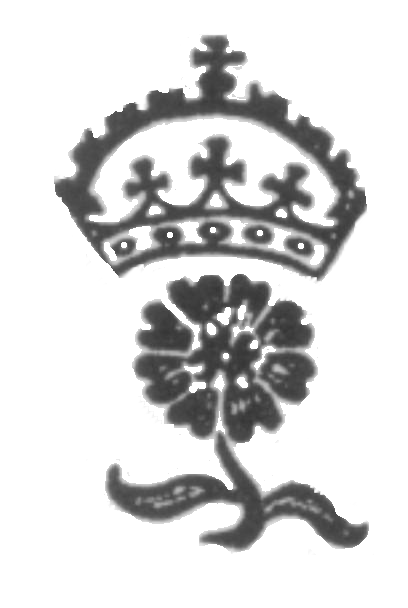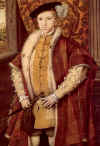About Edward VI TUDOR (King of England) (original) (raw)
**EDWARD VI
**King of England
| Born: 12 Oct 1537, Hampton Court Palace, Richmond, England Acceded: 25 Feb 1547, Westminster Abbey, London, England Died: 6 Jul 1553, Greenwich Palace, London, England Buried: Westminster Abbey, London, England Father: [HENRY VIII TUDOR (King of England)](TUDOR.htm#HENRY VIII TUDOR %28King of England%29) Mother: [Jane SEYMOUR (Queen of England)](SEYMOUR.htm#Jane SEYMOUR %28Queen of England%29) | **** ** ** |
|---|
Edward VI
attrib. to the Flemish School, 1546
See him atThe King Gallery
For more than a quarter century King Henry VIII had desperately wanted a son, and Edward's birth caused great rejoicing. The prince was baptized in a splendorous cermony in the chapel oh Hampton Court palace. But Queen Jane soon fell ill with childbed fever, and on Oct 24 she died.
Edward was initially placed in the care of Margaret Bryan, "lady mistress" of the prince's household. She was succeeded by Blanche Herbert, Lady Troy. The formal royal household established around Edward was, at first, under Sir William Sidney, and later Sir Richard Page, stepfather of Edward Seymour's wife, Anne Stanhope. Henrydemanded exacting standards of security and cleanliness in his son's household, stressing that Edward was "this whole realm's most precious jewel". Visitors described the prince, who was lavishly provided with toys and comforts, including his own troupe of minstrels, as a contented child. Until the age of six Edward was raised "among the women", as he put it later in his Chronicle; his nurse, Mother Jack, and other servants as Mrs. Penne. Sybil Penne became the chief nurse in the household of the Prince in Oct 1538 and remained in that post until 1544. During that time Henry took two wives in quick succession, but both marriages ended badly; Anne of Cleves was discarded because the King found her ugly, andCatherine Howard was executed for adultery. In 1543 Henry marriedCatherine Parr, who became a loving stepmother to Edward and his older half sisters, Mary andElizabeth. She was a highly learned woman who personally oversaw Prince Edward's education.
Edward's tutors taught him geography, government, history, French, German, Greek, and Latin. He was also given lessons in etiquette, fencing, horseback riding, music and other gentlemanly pursuits. The King arranged for a privileged group of fourteen well-born children to share his education, and thus envolved an exclusive palace school. Edward�s companion included Henry Brandon, the young Duke of Suffolk; Henry, Lord Hastings; Robert Dudley; Henry Sidney; and possibly even another cousin, Lady Jane Grey. The Prince favorite companion seems to have been Barnaby Fitzpatick, a cousin of the Earl of Ormonde (when Edward became King Barnaby was appointed to the unenviable port of royal whipping boy, which meant that he had to suffer the punishments that their governors would not dare to administer to the Lord�s Anointed, their sovereign).
Although Edward was serious and studious, at times he displayed a savage temper. Reginald Pole, later Archbishop of Canterbury, heard from people that, in front of his tutors, the young King, in a fit of anger, tore a living falcon into four pieces.
Because Elizabeth was only four years his senior, Edward was naturally closer to her than to Mary. His letters to her were warm and affectionate.
Henry VIII died in 1547 and his nine-year-old son became King Edward VI. A council was appointed by his father to rule during his minority. But Edward's uncle, the Edward Seymour, lord Hertford (Jane Seymour's brother), wanted to be Protector of the country and the King.
He entrusted Sir William Paget with the safe-keeping of **King Henry**�s will, and had no intention of showing it to anyone else until he had taken possession of the person of the new King and brought him to London. Hertford wasted no time; he left Whitehall with Sir Anthony Browne and galloped to Ashdrige, where Edward was staying. They decided that it would be better to take the Prince to Enfield so that he could be with his sister Elizabeth when the news of their father�s death was broken to them. Hertford announced the death of their royal father in the presence chamber of Enfield, and made formal obeisance on his knees to Edward as King. Both children burst into uncontrollable sobs, which were so heart-rending that their servants were soon crying too. So long did their lamentations continue that the Earl and his attendants became concerned, but at lenght Edward and Elizabeth calmed themselves. Already a change was taking place, as both became conscious of their altered roles in life. Never again would they be so close.
On 17 Feb 1547 Edward VI was knighted by Hertford, who was himself created Duke of Somerset and Earl Marshall (an office vacant as a result of the Duke of Norfolk imprisonment). At the same time, John Dudley, Viscount Lisle, was created Earl of Warwick.
Somerset's brother, Lord High Admiral Thomas Seymour, was jealous of ** Somerset**and schemed to put himself in power.
Edward had been easing the Admiral out of his life and when the Admiral tried for a late-night visit (armed with a pistol of all things) he shot the King's small dog. That was it for Seymour. Very few in the world would forgive the murder of a beloved pet.
Thomas Seymour played Edward VI for a fool, counting on the young king's continuing good will and the fact that he was a favoured uncle. Edward was showing signs of becoming independent and more self-reliant; he was the King and he knew it.
Edward VI was moving from child to man, and was starting to see things in that light. For Thomas' part, he was so busy trying to undermine his older brother that he never realized that the King himself would prove his undoing.
The Admiral was arrested and charged with treason. ** Somerset**hesitated to sign his brother's death warrant, so Edward gave the council permission to have his uncle beheaded. Somerset himself later fell from the king's favor and lost his role as Protector. John Dudley, Earl of Warwick, took control of the King and council, and eventually Somerset, like his brother, was arrested and charged with treason. Under pressure from Dudley, now Duke of Northumberland, fourteen-year-old Edward signed Somerset's death warrant. Somerset was executed in 1552. From the entries in his Journal, Edward VI uncles' deaths was merely Royal business as usual.
Edward VIs journalwas not a real dairy in the sense people look upon one. It was an intellectual exercise devised by John Cheke. Sir John would go over every entry and check it for errors, so the young King would not put his real feelings in it. He did once disarmn Northumberland with a very sarcastic remark concerning Northumberlands role in his uncles execution. It is also recored that he and Archbishop Cramner had many dicussions as to why herittics needed to be burned, he was against it.
Even given that the journal was an intellectual/scholastic exercise, Edward still saw the need for things to be done, and did not waste a lot of energy in regret. Mary was better at this than Elizabeth, once** Mary** had decided on a course of action. She might not be happy about it, but once decided, she went forward. Elizabeth was the most emotional of the three. A prime example was the execution of her cousin, Mary, Queen of Scots.
By this time Edwardhad completed his education and was participating in council meetings. It was decided that the King would take charge of the country at age sixteen. This was bad news for his sister Mary, an ardent Catholic who refused to cooperate withEdward's religious reforms. However, Edward got along well with his other sister, Elizabeth, a moderate Protestant.
Unlike his father, Edward displayed little interest in sports, preferring intellectual pastimes. He was a king not only born but educated to rule. Even Erasmus would have approved so perfect an education for a Christian prince. Richard Cox and John Cheke became his tutors, and from them he learnt not only languages but biblical piety. Other princes received ideal educations and learnt nothing, but here was a prince who prepared himself with great discipline for what he saw as the divine obligation of his kingship. He studied history. Its lessons must be put into practice; so he took notes upon English rule in France in Henry VI's reign. He studied geography. He knew all the ports and havens in England, France and Scotland, and the favourable winds and tides for entering them, for a king needed strategic information. He learnt the names and religion of every magistrate, the better to govern. But above all, he knew the scriptures. Edward's youthful passion was to hear sermons, and as he listened he took notes, especially when the preachers touched upon the duties of kings.
Edward suffered a bout of smallpox in Apr 1552, and from that time his health declined. By the next spring it was obvious that the King was dying of consumption (tuberculosis). His father's will had specified that Mary should become Queen ifEdward died without children, but Northumberland had different ideas. He persuaded Edward to name the Protestant Jane Grey as his successor (see his will). Lady Jane was the granddaughter of Henry VIII's sister Mary; she was also**Northumberland's daughter-in-law, and through her Northumberland** hoped to rule England.
On 6 Jul 1553 Edward whispered his last prayer and died. He was fifteen years old.

